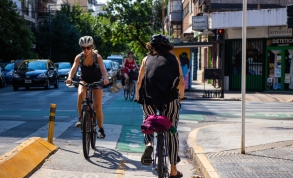Related Content

Physical activity
Active travel cuts carbon and improves health in New Zealand

Physical activity
The three European cities London, Stockholm and Milan introduced cordon urban road pricing schemes to reduce traffic congestion and air pollution. The schemes charge private vehicles with the aim to reduce environmental impacts, accidents, and congestion in the cities.
Road pricing schemes charging private vehicles have been introduced to reduce congestion and air pollution in urban areas. The three largest urban road pricing schemes in Europe started in London in 2003, in Stockholm in 2006, and in Milan in 2008. Each road pricing system applies charges differently. However, the main aim, which is to shift travel behaviour by increasing the cost of car trips, is common to all three cities. All three charges operate in the daytime and cover the core areas of the cities. The pricing schemes further present exemptions, such as for public transport vehicles, and all three systems evolved over time with changes made to the area, exemptions, and other features.
In London, the scheme covers 21km2 (1.3% of city surface), and the charge level ranged from a £5 daily fee when it first started and increased to £11.50 (14.50€) by 2014. In Stockholm the scheme covers 30km2 (16% of the city surface), with the charge per day varying between SEK 10 to 20 (1.08€ to 2.16€) depending on time, with the total charge per day capped at SEK 60 (6.50€). Lastly, in Milan the scheme was applied to 8km2 of the city (4.5% of the city surface), and it includes a pollution charge that varies from 0€ to 10€ per day depending on vehicle’s emission class and a flat congestion charge of 5€ per day.
Assessments of the three pricing schemes showed that they reduced congestion and traffic emissions, and encouraged a modal shift from using private to public transport.
The schemes also resulted in reductions in traffic accidents in London and Milan, but a change in the rate of accidents was not measured in Stockholm. In London, there was a 9% reduction in accidents in the first year, and in Milan there was a 21.3% reduction in accidents in 2011 compared with 2007, before the implementation of the road pricing scheme.
The pricing schemes further resulted in reductions of PM10 levels. A reduction of 15% was reported in London, 13% in Stockholm, and a 15% reduction was observed in Milan. In London a 13% reduction of NOx levels were also measured.
The assessments showed a 16% reduction and 13% reduction in CO2 levels in London and Stockholm, respectively. CO2 emission reductions were not measured in Milan.
An economic assessment estimated that the scheme resulted in annual gross revenues between 175.5 million Euros to 288.6 million Euros in London in 2012, 83.2 million Euros in Stockholm and from 12 million Euros in 2008 to 5.9 million Euros in 2011 in Milan.
It is estimated that in European cities, the negative impacts of traffic, i.e. air pollution, traffic accidents, noise and greenhouse gas emissions, cause economic damage of around 100 billion Euros each year. The three road pricing schemes demonstrated the positive impact of such schemes with regards to emission reductions and health.
Political and public debate were important factors in the establishment and the continuation of these schemes. Historically, restrictive transport policies are not popular among the public and have led to populist backlash (Aasen and Sælen, 2022). Public opposition is one of the main obstacles why road pricing schemes are not more widely introduced. Opposition is often influenced by self-interest and perceptions of infringement on freedom negatively impacts attitudes. What is however often underestimated is the fact that once implemented attitudes become more positive because the benefits are underestimated. Once the benefits appear, the attitudes become more positive towards the road pricing schemes. In all three cities, pre-implementation polls showed that citizens were not in favour of these charges, however, after implementation opinions changed and citizens showed a favourable opinion towards the intervention. Further, in Stockholm and Milan a referendum was a key decisive factor.
Moreover, for congestion charges to be effective and accepted by the public, a credible alternative to private cars should be provided. In London, Stockholm, and Milan, public transportation was increased after the implementation of the scheme, and a large amount of the revenues from the scheme were invested in sustainable mobility. In London, for example, the road space freed from cars was re-purposed for bike lanes and pedestrian areas.